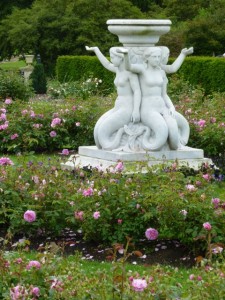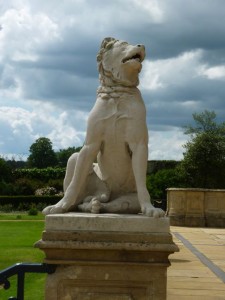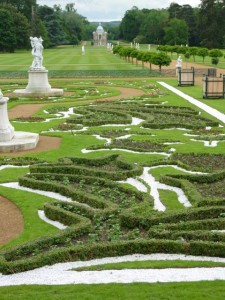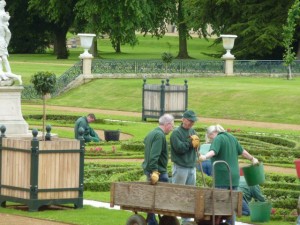
Bedfordshire? Never given it much thought beyond gritting my teeth over the drive to Luton airport. A prejudice I don’t mind defending as many have never heard of Suffolk, where I’m from, at all.
This non view got swept into a cocked hat or french drain two days back when travels along a beaded necklace of roundabouts through green sameyness brought the car to Silsoe and me to a breathtaking standstill.
On the outskirts of the village the JCBS are at orgy pitch working behind crash barriers scooping their hasty way through the top-soil to build a perfect satellite village. How well will itmarry with the main street, Betjeman’s England, timber-framed and leaning? Domestic housing peters out by a pair of pepper pot, decidedly french-looking lodge houses.
Beyond, the parkland rolls off into uninterrupted agricultural view; trees giving way to crops and clouds. The land is empty apart from a man on an immense mower under an avenue of trees. English Heritage have kept their signage to a minimum and I overshoot, distracted entirely by the bastion of garden wall that runs and runs along the right had side of the drive. That, for the lover of vital statistics, surrounds what was a 6 acre kitchen garden.

Wrest park. Never heard of it? The index of my book on Capability Brown is schtum on this one. Checked with art historian bro in law and a landscape architect friend. Phew, not alone in knowing nothing.
The acres roll out, the house unfolds, french with a certain cut to the roof domes which along with the Long Water behind the house, give just a hint of the Mughal.
Wrest Park. An estate that remained in the same family for 700 years, from the early 13th century until the end of the 1st world war when the de Greys sold house, grounds and shooting estate to a Mr Murray who lurks in the plot like a bad fairy. Statues sold off willey nilley. But compare Wrest’s lot to the post war fate of some of the great houses of England, imploded into their marble basements with gunpowder. It got off pretty lightly.
Mr Murray ran out of money and Wrest Park spent the rest of the twentieth century shuffling between Ministries. Shuntering along in white elephant gait. Until picked up by English Heritage and a large Heritage Lottery grant to restore house and estate. The Head Gardener, Chris Slatcher has been working in the grounds for 30 years and is presiding over a transformation from decrepitude and harsh blue railings.
The grounds of Wrest Park will be a mecca for the student of english garden history. Wrest is well documented in diaries and letters by de Greys down the centuries. And indexed with plans by the likes of Kip and Kynff. The layers are present of the different fashions and influences that dictated the look of the English garden and wider landscape over hundreds of years.

The key is that improvements did not sweep away what had come before and fallen off the soup plate of fashion. You will see ideas borrowed from the Villa Lante, a formal wooded garden in the french style, Le Notre’s influence writ large on the Long Water. A landscape of statues and allegory is tempered by the formality of site lines and paths and a lavish collection of statues, (Notwithstanding Mr Murray, oh and before him, many of the lead ones were melted down to put the roof back on the old house in 1809).
The new was worked in with the old. There are two very telling instances of this. Launcelot Brown, called on as a family friend, was invited to deformalise certain rides, and cast his hydraulic wizardry round the outer garden. His work is restrained and does not attempt to sweep the canvas bare. Horace Walpole’s take was: “very ugly in the old fashioned manner”. Clearly no charge of ‘fashion victim’ can be laid.
[caption id="attachment_1856" align="alignleft" width="300" caption="volunteers at work"]

[/caption]
The old drafty house was knocked down in 1831 by Thomas Robinson, 2nd Earl de Grey and founder member of the Royal Institute of Architects. Rebuilt in the french style, the new building is several hundred metres back from the original site but carefully aligned to knit with the garden that already existed. It is worth standing inside to check the site lines out into the formal garden but also into the far distance of the kitchen garden.
The house has incredible plasterwork ceilings and rare wallpapers, some moved from the older building. And beside the mansion, one of the first bespoke Service-wings built in England. Room to swallow the army of the servants necessary to run a such an establishment.
As an end note, the gardens round the house look immaculate; intensive bedding plants drilled to perfection. This, according to Chris Slatcher, is only possible due to the well marshalled army of volunteers who help the permanent gardening staff of 3. Ninety acres under horticultural management is a tall order.
 Bedfordshire? Never given it much thought beyond gritting my teeth over the drive to Luton airport. A prejudice I don’t mind defending as many have never heard of Suffolk, where I’m from, at all.
This non view got swept into a cocked hat or french drain two days back when travels along a beaded necklace of roundabouts through green sameyness brought the car to Silsoe and me to a breathtaking standstill.
On the outskirts of the village the JCBS are at orgy pitch working behind crash barriers scooping their hasty way through the top-soil to build a perfect satellite village. How well will itmarry with the main street, Betjeman’s England, timber-framed and leaning? Domestic housing peters out by a pair of pepper pot, decidedly french-looking lodge houses.
Beyond, the parkland rolls off into uninterrupted agricultural view; trees giving way to crops and clouds. The land is empty apart from a man on an immense mower under an avenue of trees. English Heritage have kept their signage to a minimum and I overshoot, distracted entirely by the bastion of garden wall that runs and runs along the right had side of the drive. That, for the lover of vital statistics, surrounds what was a 6 acre kitchen garden.
Bedfordshire? Never given it much thought beyond gritting my teeth over the drive to Luton airport. A prejudice I don’t mind defending as many have never heard of Suffolk, where I’m from, at all.
This non view got swept into a cocked hat or french drain two days back when travels along a beaded necklace of roundabouts through green sameyness brought the car to Silsoe and me to a breathtaking standstill.
On the outskirts of the village the JCBS are at orgy pitch working behind crash barriers scooping their hasty way through the top-soil to build a perfect satellite village. How well will itmarry with the main street, Betjeman’s England, timber-framed and leaning? Domestic housing peters out by a pair of pepper pot, decidedly french-looking lodge houses.
Beyond, the parkland rolls off into uninterrupted agricultural view; trees giving way to crops and clouds. The land is empty apart from a man on an immense mower under an avenue of trees. English Heritage have kept their signage to a minimum and I overshoot, distracted entirely by the bastion of garden wall that runs and runs along the right had side of the drive. That, for the lover of vital statistics, surrounds what was a 6 acre kitchen garden.
 Wrest park. Never heard of it? The index of my book on Capability Brown is schtum on this one. Checked with art historian bro in law and a landscape architect friend. Phew, not alone in knowing nothing.
The acres roll out, the house unfolds, french with a certain cut to the roof domes which along with the Long Water behind the house, give just a hint of the Mughal.
Wrest Park. An estate that remained in the same family for 700 years, from the early 13th century until the end of the 1st world war when the de Greys sold house, grounds and shooting estate to a Mr Murray who lurks in the plot like a bad fairy. Statues sold off willey nilley. But compare Wrest’s lot to the post war fate of some of the great houses of England, imploded into their marble basements with gunpowder. It got off pretty lightly.
Mr Murray ran out of money and Wrest Park spent the rest of the twentieth century shuffling between Ministries. Shuntering along in white elephant gait. Until picked up by English Heritage and a large Heritage Lottery grant to restore house and estate. The Head Gardener, Chris Slatcher has been working in the grounds for 30 years and is presiding over a transformation from decrepitude and harsh blue railings.
The grounds of Wrest Park will be a mecca for the student of english garden history. Wrest is well documented in diaries and letters by de Greys down the centuries. And indexed with plans by the likes of Kip and Kynff. The layers are present of the different fashions and influences that dictated the look of the English garden and wider landscape over hundreds of years.
Wrest park. Never heard of it? The index of my book on Capability Brown is schtum on this one. Checked with art historian bro in law and a landscape architect friend. Phew, not alone in knowing nothing.
The acres roll out, the house unfolds, french with a certain cut to the roof domes which along with the Long Water behind the house, give just a hint of the Mughal.
Wrest Park. An estate that remained in the same family for 700 years, from the early 13th century until the end of the 1st world war when the de Greys sold house, grounds and shooting estate to a Mr Murray who lurks in the plot like a bad fairy. Statues sold off willey nilley. But compare Wrest’s lot to the post war fate of some of the great houses of England, imploded into their marble basements with gunpowder. It got off pretty lightly.
Mr Murray ran out of money and Wrest Park spent the rest of the twentieth century shuffling between Ministries. Shuntering along in white elephant gait. Until picked up by English Heritage and a large Heritage Lottery grant to restore house and estate. The Head Gardener, Chris Slatcher has been working in the grounds for 30 years and is presiding over a transformation from decrepitude and harsh blue railings.
The grounds of Wrest Park will be a mecca for the student of english garden history. Wrest is well documented in diaries and letters by de Greys down the centuries. And indexed with plans by the likes of Kip and Kynff. The layers are present of the different fashions and influences that dictated the look of the English garden and wider landscape over hundreds of years.
 The key is that improvements did not sweep away what had come before and fallen off the soup plate of fashion. You will see ideas borrowed from the Villa Lante, a formal wooded garden in the french style, Le Notre’s influence writ large on the Long Water. A landscape of statues and allegory is tempered by the formality of site lines and paths and a lavish collection of statues, (Notwithstanding Mr Murray, oh and before him, many of the lead ones were melted down to put the roof back on the old house in 1809).
The new was worked in with the old. There are two very telling instances of this. Launcelot Brown, called on as a family friend, was invited to deformalise certain rides, and cast his hydraulic wizardry round the outer garden. His work is restrained and does not attempt to sweep the canvas bare. Horace Walpole’s take was: “very ugly in the old fashioned manner”. Clearly no charge of ‘fashion victim’ can be laid.
[caption id="attachment_1856" align="alignleft" width="300" caption="volunteers at work"]
The key is that improvements did not sweep away what had come before and fallen off the soup plate of fashion. You will see ideas borrowed from the Villa Lante, a formal wooded garden in the french style, Le Notre’s influence writ large on the Long Water. A landscape of statues and allegory is tempered by the formality of site lines and paths and a lavish collection of statues, (Notwithstanding Mr Murray, oh and before him, many of the lead ones were melted down to put the roof back on the old house in 1809).
The new was worked in with the old. There are two very telling instances of this. Launcelot Brown, called on as a family friend, was invited to deformalise certain rides, and cast his hydraulic wizardry round the outer garden. His work is restrained and does not attempt to sweep the canvas bare. Horace Walpole’s take was: “very ugly in the old fashioned manner”. Clearly no charge of ‘fashion victim’ can be laid.
[caption id="attachment_1856" align="alignleft" width="300" caption="volunteers at work"] [/caption]
The old drafty house was knocked down in 1831 by Thomas Robinson, 2nd Earl de Grey and founder member of the Royal Institute of Architects. Rebuilt in the french style, the new building is several hundred metres back from the original site but carefully aligned to knit with the garden that already existed. It is worth standing inside to check the site lines out into the formal garden but also into the far distance of the kitchen garden.
The house has incredible plasterwork ceilings and rare wallpapers, some moved from the older building. And beside the mansion, one of the first bespoke Service-wings built in England. Room to swallow the army of the servants necessary to run a such an establishment.
As an end note, the gardens round the house look immaculate; intensive bedding plants drilled to perfection. This, according to Chris Slatcher, is only possible due to the well marshalled army of volunteers who help the permanent gardening staff of 3. Ninety acres under horticultural management is a tall order.
[/caption]
The old drafty house was knocked down in 1831 by Thomas Robinson, 2nd Earl de Grey and founder member of the Royal Institute of Architects. Rebuilt in the french style, the new building is several hundred metres back from the original site but carefully aligned to knit with the garden that already existed. It is worth standing inside to check the site lines out into the formal garden but also into the far distance of the kitchen garden.
The house has incredible plasterwork ceilings and rare wallpapers, some moved from the older building. And beside the mansion, one of the first bespoke Service-wings built in England. Room to swallow the army of the servants necessary to run a such an establishment.
As an end note, the gardens round the house look immaculate; intensive bedding plants drilled to perfection. This, according to Chris Slatcher, is only possible due to the well marshalled army of volunteers who help the permanent gardening staff of 3. Ninety acres under horticultural management is a tall order. 